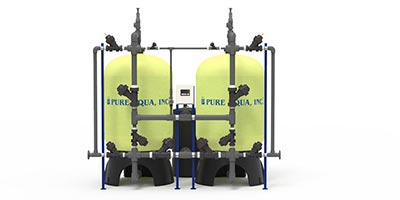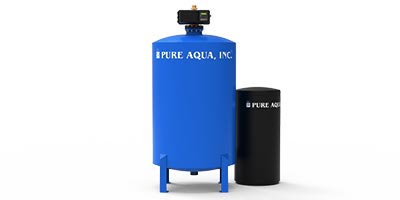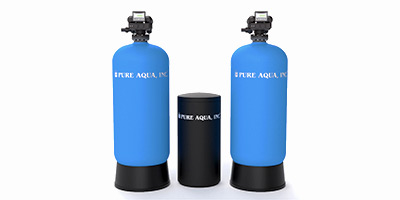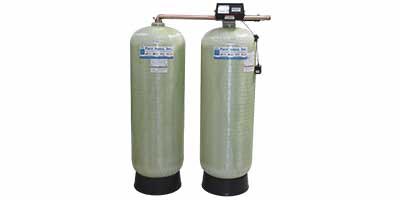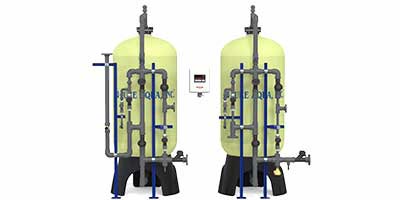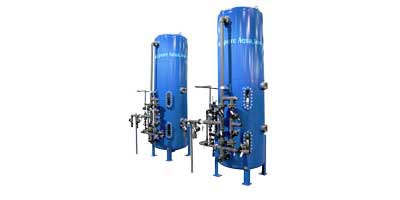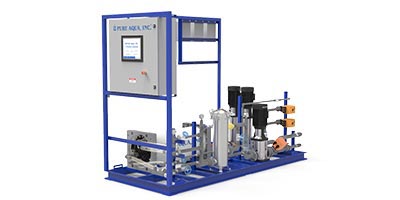Ion Exchange Water Treatment Systems
Pure Aqua engineers and manufactures a complete range of ion exchange water treatment systems utilizing both conventional and advanced water treatment technologies. Our engineers work diligently to provide our customers with proven and reliable ion exchange water filter equipment. Please take the time to browse our extensive catalog below detailing both custom and pre-engineered ion exchange filtration solutions.
Exchange Capacity
160K to 4,200K Grains
Service Flow Rates:
40 to 1,000 GPM
- Epoxy Coated Carbon Steel Tanks
- Diaphragm or Butterfly Valves
- Digital Stager or PLC
- Tanks: 24" to 84" Diameter
Exchange Capacity
90K to 1,800K Grains
Service Flow Rates:
15 to 300 GPM
- Fiberglass (FRP) Tanks
- Diaphragm or Butterfly Valves
- Digital Stager or PLC
- Tanks: 14" to 63" Diameter
Exchange Capacity
90K to 210K Grains
Service Flow Rates:
19 to 220 GPM
- Epoxy Coated Carbon Steel Tanks
- Fleck Control Valves
- Automatic or Manual Backwash Valves
- Tanks: 14" to 60" Diameter
Exchange Capacity
60K to 1,800K Grains
Service Flow Rates:
18 to 300 GPM
- Fiberglass (FRP) Tanks
- Fleck Control Valves
- Automatic or Manual Backwash Valves
- Tanks: 12" to 63" Diameter
Exchange Capacity
15K to 600K Grains
Service Flow Rates:
8 to 95 GPM
- Fiberglass (FRP) Tanks
- Magnum Autotrol Control Valves
- Automatic Backwash Valve
- Tanks: 7” to 36” Diameter
Exchange Capacity
60K to 1,800K Grains
Service Flow Rates:
9 to 300 GPM
- Fiberglass (FRP) Tanks
- Clack Control Valves
- Automatic Backwash Valve
- Tanks: 7" to 63" Diameter
Exchange Capacity
15K to 300K Grains
Service Flow Rates:
8 to 30 GPM
- Fiberglass (FRP) Tanks
- Fleck Control Valves
- Automatic Backwash Valve
- Tanks: 7" to 24" Diameter
Exchange Capacity
15K to 300K Grains
Service Flow Rates:
11 to 49 GPM
- Fiberglass (FRP) Tanks
- Fleck Control Valves
- Automatic Backwash Valve
- Tanks: 7" to 24" Diameter
Exchange Capacity
40K to 100K Grains
Service Flow Rates:
2 to 14 GPM
- Fiberglass (FRP) Tanks
- Diaphragm Valves
- Digital Stager
- Auto regeneration
Exchange Capacity
200K to 800K Grains
Service Flow Rates:
11 to 135 GPM
- Fiberglass (FRP) Tanks
- Diaphragm and Butterfly Valves
- Digital Stager or PLC
- Auto regeneration
Exchange Capacity
450 to 3000 Grains
Service Flow Rates:
0.13 to 1.25 GPM
- Standard and Big Blue Housings
- Softening or Deionizing Cartridges
- Testlight Quality Indicator
- Compact Units
Exchange Capacity
62K to 450K Grains
Service Flow Rates:
18 to 190 GPM
- Rubber Lined Carbon Steel Tanks
- Diaphragm and Butterfly Valves
- Digital Stager or PLC
- Auto regeneration
Service Flow Rates:
2 to 220 GPM
(0.5 to 50 M³/hr)
- No Chemical Regeneration
- Small, Compact Modules
- Produces Water up to 18 Megaohm-cm
Pure Aqua has over 20 years of experience as a world-wide supplier of ion-exchange systems for water softening applications and other related types of needs. Our large stock of ion-exchange systems are designed to removal hardness minerals from water efficiently and with low-energy usage.
What does ion exchange remove?
- Hardness removal (water softener)
- Nitrate removal from water
- Alkalinity
- Chloride removal
- Sulfates
- Fluorides
- Organics reduction
- Silica removal
- Perchlorate
- Radium and Uranium removal
- Arsenic removal
- Barium removal
- Boron removal
- TDS reduction
All Pure Aqua ion exchange water filters incorporate the latest resin technology utilizing the highest quality resins furnished by well-known manufacturers. Our unique Regenerate Distribution System accomplishes complete and uniformed regeneration of the resin. The ion exchange water treatment systems also include state of the art PLC based or digital stager regeneration controls to assure consistency and reliability.
Advantages of Ion exchange water filter systems:
- Fast results
- Short and long-term applications
- Variety of tank sizes.
- Allows for quick installations.
- Requires minimal maintenance
What are ions in water?
Ions are electrically charged molecules, and are formed as pollutants dissolve in water. Natural areas of water have a balance of positively and negatively charged ions. Ions are what determine the TDS and conductivity of the water. The greater presence of ions results in higher TDS and conductivity.
How does ion exchange water treatment work?
Ion exchange water treatment works by removing material from the water through the use of water processes such as water softening, and water deionization. These systems work by exchanging specific ions for other ions. When it comes to water softeners, magnesium and calcium ions are replaced by sodium ions. As for water deionization systems, the cations are exchanged for hydrogen ions, while the anions are exchanged for hydroxyl ions.
 ENGLISH
ENGLISH ESPAÑOL
ESPAÑOL العربية
العربية PORTUGUÉS
PORTUGUÉS FRANÇAIS
FRANÇAIS


